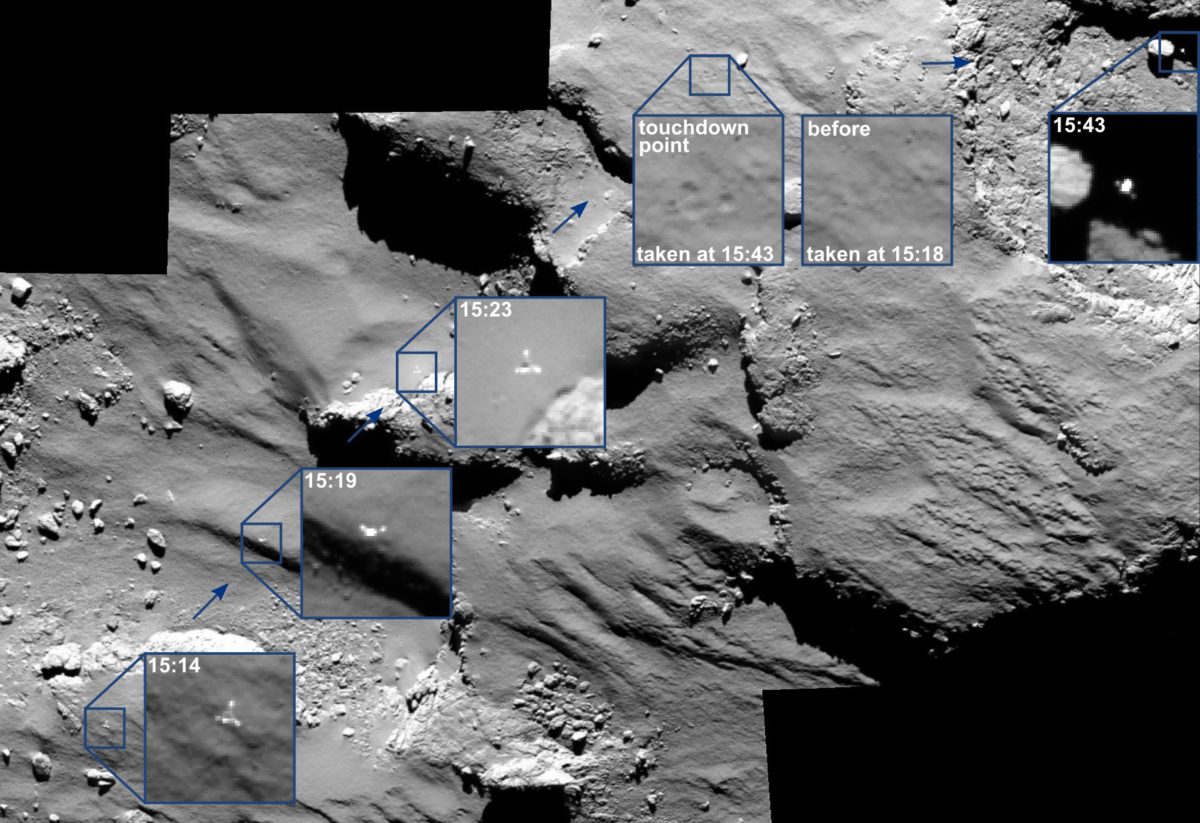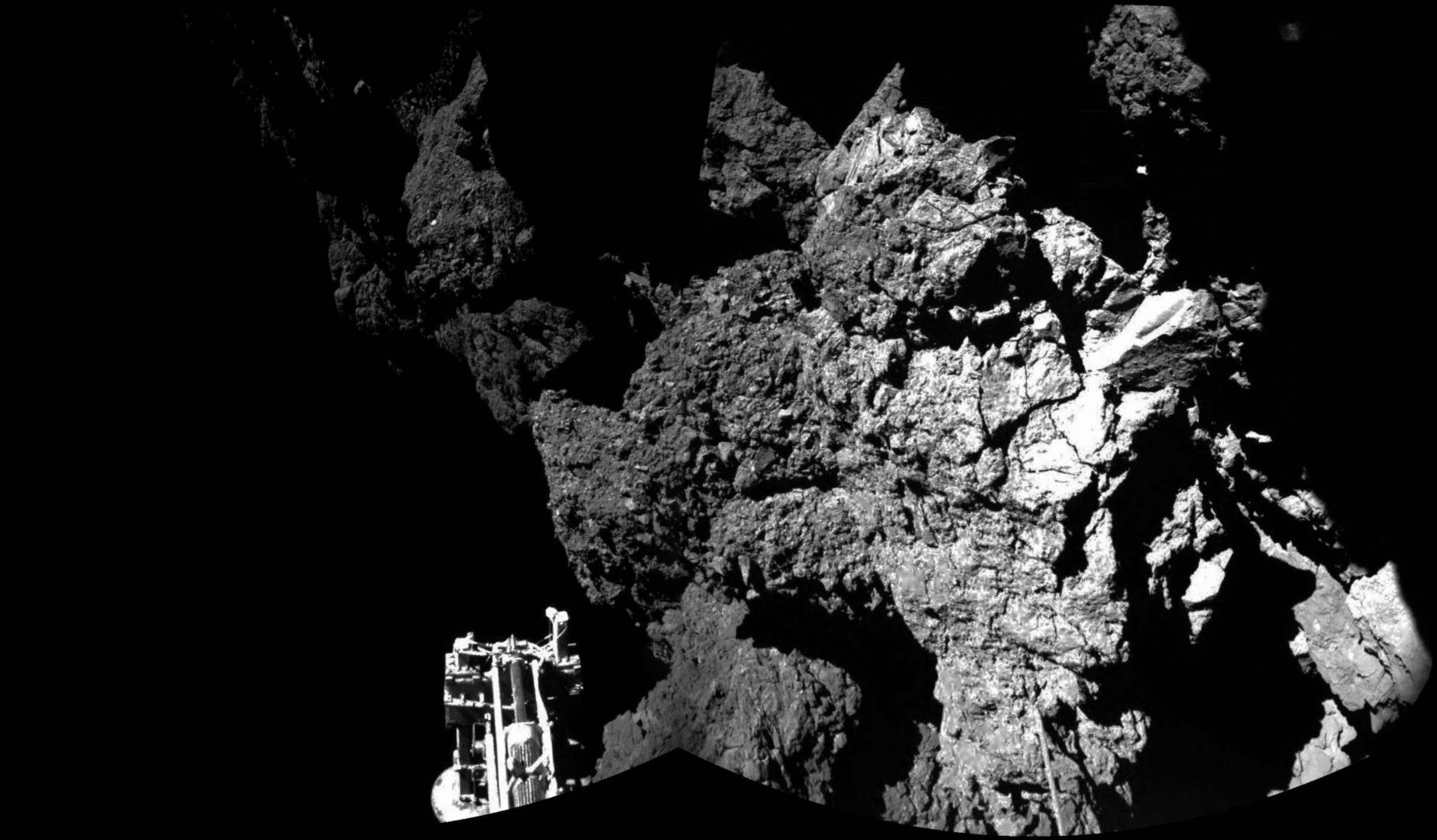Emily Lakdawalla • Mar 18, 2015
LPSC 2015: Philae at comet Churyumov-Gerasimenko
Well, it was a whirlwind couple of days in Houston at the Lunar and Planetary Science Conference. Here are a few highlights of the meeting. I've learned that the only way to get LPSC blog posts off of my computer and into the wild is to publish them in small chunks, so I'll begin at the beginning with the three talks I attended on the Philae comet lander. Links at the beginnings of these paragraphs take you to two-page conference abstracts, in PDF format.
Stefano Mottola talked about analysis of images from ROLIS, the descent camera, which include the area of Philae's first touchdown. It was an area, he said, whose landscape was dominated by mantling deposits derived from airfall of comet particles. He showed images on which he mapped parallel sets of ridges, talking about them as "aeolian" features, and even pointed out that the large boulder present in the ROLIS descent images has a moat and a windtail, just as large boulders do in deserts on Earth. The "moat" was clear in an image from his presentation, made from a digital elevation model computed from a pair of ROLIS images shot at slightly different angles. Now, an airless body with virtually no gravity cannot have wind creating sand dunes and windtails as Earth deserts do. Mottola suggested that the particles on the surface of the comet might get pushed into motion to create dune-like features by splashing effects -- falling particles kicking surface particles off the surface, setting off waves of motion. Paul Rincon wrote more about these windtails at BBC News.

Ian Wright walked the audience through the Ptolemy mass spectrometer results that Philae took immediately after landing. They're a challenge to interpret because they were taken in a geometry that they had not practiced for -- that is, while floating through the sky above the comet. In fact, Wright said, the measurement was made several minutes after landing, at about the same time that OSIRIS snapped the image of Philae floating away from its landing site:

Despite the unplanned-for flight, Ptolemy did ingest something from the space around the comet, and there is a mass spectrum to interpret. Wright showed that the mass spectrum is somewhat rhythmic in its form, with a decaying series of peaks from lower to higher masses. That, he said, is the hallmark of the presence of some kind of polymer, which breaks into longer or shorter chains of subunits, producing this kind of rhythmic mass spectrum. He said that the Giotto mass spectrometer, PICCA, saw something similar at Halley, detecting polyoxymethylene, which is a polymer made of sets of carbon atoms linked to two hydrogens and one oxygen. "Once you've accepted that," he said, "there are other interesting things," such as the lack of any detection of nitrogen at a mass of 14, and similarly, no sulfur at mass 34. There is a peak at mass 28, likely representing carbon monoxide. Apart from that, he said, "Everyone keep your fingers crossed for Philae waking up, because clearly we've got a working instrument that could make some good measurements at the surface of a comet." Wright punctuated his talk with stills from this adorable cartoon, recently released by ESA:
The final Philae talk was by Jean-Pierre Bibring, on the images taken by the panoramic ÇIVA camera after the final landing. His talk mostly presented information I've blogged about before, but there were a few tidbits that show developing science. He said that the albedo of the surface observed by ÇIVA ranged from 3 to 10 percent. In general, he said that the features observed by ÇIVA were mostly consistent with processes that have acted to change the appearance of the comet's surface since it formed. For instance, cracks likely result from thermal fatigue (the repeated heating and cooling of the comet surface). Angular fragments of comet material likely result from the fragmentation of the comet's surface following this thermal cracking. Bright grains appear here and there on the dark surface, likely deposited there by comet activity. Then he stepped back a little and considered what ÇIVA and OSIRIS images together tell us about the comet. He pointed out that we don't seem to see large blocks of many hundreds of meters; rather, the comet seems to be made of relatively small pebbles, on centimeter to meter scales. Even the large boulder in the ROLIS image, above, is visibly composed of smaller pieces somehow glued together. "67P could be entirely made of pebbles," he said, and suggested that the observations by Rosetta and Philae support the solar system formation modeling work of Karl Jansson and Anders Johansen on "pebble-pile planetesimals".

It is still very early to draw major conclusions from the Philae mission. After all, we still hope that the lander will wake up to do more science; Rosetta is now listening for the lander regularly. I talked with Philae lander manager Stefan Ulamec at the LPSC poster session yesterday, and (as he has said ever since landing day) he still does not expect to hear anything from the lander until at least May.
I talked with other comet scientists about the Philae talks afterwards, and they were dubious about Mottola's aeolian interpretation of the landforms on the comet. The thing is, you have tiny masses experiencing tiny forces under nearly zero gravity; there's no lab work you can do on Earth that can help you understand the physics that's at play here. But the ROLIS images will give us a starting point, at least, telling us what it is that we need to understand. If I had to generalize from what I saw at the Philae session, it's to say that physics at very small scales is very important in comets -- in how they are put together, and how they behave. So it's a good thing we sent a lander down to the surface to tell us what it looks like, and we have a lot left to learn from Philae.
I did not attend any Rosetta talks at the conference, so I'm grateful to the other LPSC microbloggers who attended and tweeted. Here is a sampling of Rosetta results from later in the session:
Standing room only still in the #Rosetta talks. #LPSC2015 pic.twitter.com/98mnCXbIXm
— Stuart Robbins (@DrAstroStu) March 16, 2015#rosetta: comet nucleus has density ~470 kg/m3. 70-80% porosity. Surface appears ice free. #LPSC2015
— Alyssa Rhoden (@aRhoDynamics) March 16, 2015Sierks: 67P's updated rotation rate is 20 minutes faster. #LPSC2015 #Rosetta
— Mike Bramble (@mbramble) March 16, 2015Sierks: The 10 m Cheops boulder looks like a comet itself. A comet on a comet! #LPSC2015 #Rosetta
— Mike Bramble (@mbramble) March 16, 2015Sierks: 1/2 m boulder, among others, seen in cometary orbit around 67P. #LPSC2015 #Rosetta
— Mike Bramble (@mbramble) March 16, 2015Major species seen by Rosina on @ESA_Rosetta: H2O, CO2, and CO. Dependent on latitude #LPSC2015
— The Science Dick (@TheScienceDick) March 16, 2015Jäckel: Anti-correlation seen in H20 and CO2 signals, and it's a function of the latitude of the comet. #LPSC2015 #Rosetta
— Mike Bramble (@mbramble) March 16, 2015Rosetta ROSINA results aren't evidence that Jupiter-family comets didn't bring water to Earth. #doublenegative #LPSC2015
— The Science Dick (@TheScienceDick) March 16, 2015Rosetta team to propose to ESA extension of mission to mid-2016. End game is spiraling close to the comet, science within 1km. #LPSC2015
— Stephen Clark (@StephenClark1) March 16, 2015Let’s Go Beyond The Horizon
Every success in space exploration is the result of the community of space enthusiasts, like you, who believe it is important. You can help usher in the next great era of space exploration with your gift today.
Donate Today

 Explore Worlds
Explore Worlds Find Life
Find Life Defend Earth
Defend Earth

